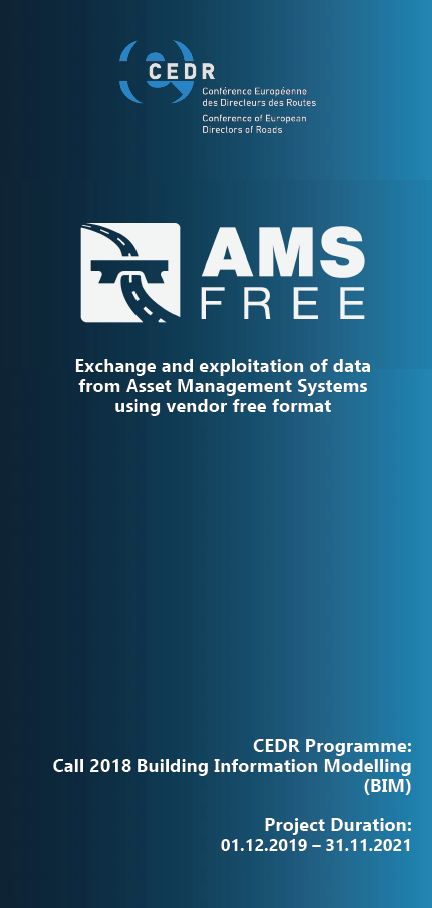The AMSFree project analyses the architecture of Infrastructure Asset Management Systems (IAMSs) used by National Road Authorities (NRAs), as well as the asset information content in current IAMSs in order to establish detailed technical requirements for linking IAMS and Building Information Models (BIMs) as infrastructure asset databases on a macro and micro level. The analysis is performed on a range of BIM models utilized by designers and contractors, so the level of development (LOD) for the common infrastructure asset BIM can be agreed on.
To allow full utilization of state-of-the-art data acquisition techniques (sensors and drones etc.), requirements for existing condition assessment techniques are established. The acquisition technologies are analyzed regarding output data format and suitability for the condition assessment of specific asset type. The format and content of the standard in-depth testing methods output data, as well as the remote sensing IoT specifics are investigated and documented in information delivery manual (IDM) for the condition assessment of assets. Possibilities of using existing objects and relationships (defined in released and upcoming IFC standard extensions) for description of the inspection and monitoring data defined in the IDM for Infrastructure Asset Inspection are investigated and documented.
Based on the previously documented analysis, the processes of an asset management system are described using Business Process Modeling and Notation (BPMN) standard. Taking into account the existing research results, in particular those of the INTERLINK project, the content and complexity of the expected conflicts are described transparently and comprehensively. Hereafter the recommendations for handling the insufficient exchange data are established, as well as the rules for semantic transformation. All data from the source systems is transferred to a reference database by using the established transformation rules.
In order to allow BIM-data import into IAMS, the IAMS-oriented IDM is established. The processes and exchange requirements are worked out in detail so that it is possible to import data into existing systems. The exchange requirements are then formalized in accordance to European Road OTL classes and finally mapped to the Industry Foundation Classes (IFC) model in a form of defined Model View (mvdXML format). Extensions of existing IFC schema are developed where necessary. The procedure developed and the proposed implementation or extension of the IFC is defined in such a way that they can be used for all national IAMS. For the purpose of integration of national classifications using the IFC standard and the specified procedures, corresponding national property sets are defined for the three national classifications.
The semantic transformation between different legacy systems is enabled on the basis of IFC property templates, taking into account the IFC import/export capabilities of various systems. Specifically, a universal mapping approach between different IFC properties of different legacy systems is defined. For this purpose, a corresponding architecture is developed and prototypical implemented. Existing national data formats (e.g. OKSTRA, Interlis2) are linked with the IFC format. For the creation of information containers according to ISO 21597, a framework developed by the RUB is used. Thus, Information containers can be used when there is a national need for more information and to interact with existing legacy systems.
Based on the results of the previous work, the interoperability proof-of-concept is developed. The existing IAMS are selected, focusing on the NRAs that already require BIM models of infrastructure objects for as-built documentation. Afterwards, the requirements are defined to enable the linkage between the data in IAMS and the IFC model. Based on the requirement a web application is developed and documented.


